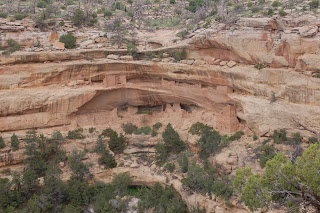Today we leave Durango and travel west to Utah and Arizona. We take a detour at Cortez, just west of Durango, to visit an Anasazi Indians - the Ancestral Puebloans - heritage site where we learn that it is important to respect these ancient sites that have cutural and spiritual significance for the current Pueblo descendants. This is important to know as we will be visiting such sites and Indian land for the rest of our trip.
At Cortez we realize that Phoebe's stuffed animal - Labit - has been left behind in the room of the Hampton Suites in Durango. But, he has been found and the hotel will send him on to Lexington. From here, we start the long drive to Four Corners. This landmark is where Arizona, New Mexico, Colorado and Utah meet at one point.
The drive takes us on long straight roads remote from any civilization and devoid of any living creatures. The landscape undulates for miles and miles with rock outcrops and small shrubs that are dotted over the red rocky soil.
Although Four Corners is very remote, there are quite a few visitors at the site. We pay our entrance fee. There is a concrete structure and a brass plate on the ground that marks the point where astronomers and geographers have located the exact point where the four states meet. We wait our turn as other people stand on the brass structure and have their photo taken. Some go to the effort of placing each foot and, bending over, each hand in a separate state.
Although it is only about 83 degrees, the sun is very hot. It is breezy and this is pleasant unless one stands in the area down wind from the pit toilets. On two sides of the landmark there are low and long open-front buildings. In each there are separate stalls belonging to approximately 30 Navajo traders. Four Corners is on Navajo Indian land. They are selling jewellery, although there are a few other things. We wander along and buy a hand-painted fridge magnet depicting the four corners. George and Max each buy a sling shot with a wolf head carved on the front.
Our drive from Four Corners to Monument Valley, Utah now begins. The drive again takes us through remote landscapes that changes from shrub to bare and dramatic outcrops of red rock. Some rock formations rise vertically from the ground. These are volcanic plugs of igneous rock that have withstood the erosion that has shaped the surrounding landscape of sedimentary rock.
Eventually in the distance we see buttes.We are approaching Monument Valley and we are seeing the huge red buttes rising from the landscape. The Valley is part of the Navajo Nation where the Dino people live. There is a fee to get into the park. As we wait in line with other cars to pay our fee we see a school bus drop off a teenager. His destination is a group of caravans in the distance down a long dusty red road.
Eventually in the distance we see buttes.We are approaching Monument Valley and we are seeing the huge red buttes rising from the landscape. The Valley is part of the Navajo Nation where the Dino people live. There is a fee to get into the park. As we wait in line with other cars to pay our fee we see a school bus drop off a teenager. His destination is a group of caravans in the distance down a long dusty red road.
Tonight we are booked into The View Hotel. We have booked this hotel months earlier before the rest of our trip was planned. Even then, most of the hotel rooms were booked. The hotel is a low long structure of red stone that blends perfectly with the red rock of the valley. Each hotel room has a balcony that faces the valley for optimum viewing of the landscape.
We purchase a piece of Navajo pottery at the trading post within the hotel. Phoebe buys a cowboy hat and we buy another fridge magnet. We like to have one fridge magnet from every state we visit.
We cook dinner for Phoebe, George and Max using the microwave in our room. Colin and I go to the restaurant to have dinner and sample the Najavo cuisine that has been highly rated within national magazines across the country. We both choose stews which are extremely tasty and Najavo fried bread which we eat with honey. No alcohol can be purchased on Navajo reservations.
Unfortunately the weather forecast for the evening is thunderstorms so we are unlikely to see the spectacular array of stars that can usually be seen when darkness falls. Instead, we watch a spectacular lightening display in the distance. Lightening flashes in four different locations. Some lightening doesn't make it do the ground but instead illuminates the cloud cover. Other sheet lightening touches the ground as strong bright vertical flashes and yet more sheet lightening flashes horizontally across the sky under the clouds. It is awe-inspiring.




















































